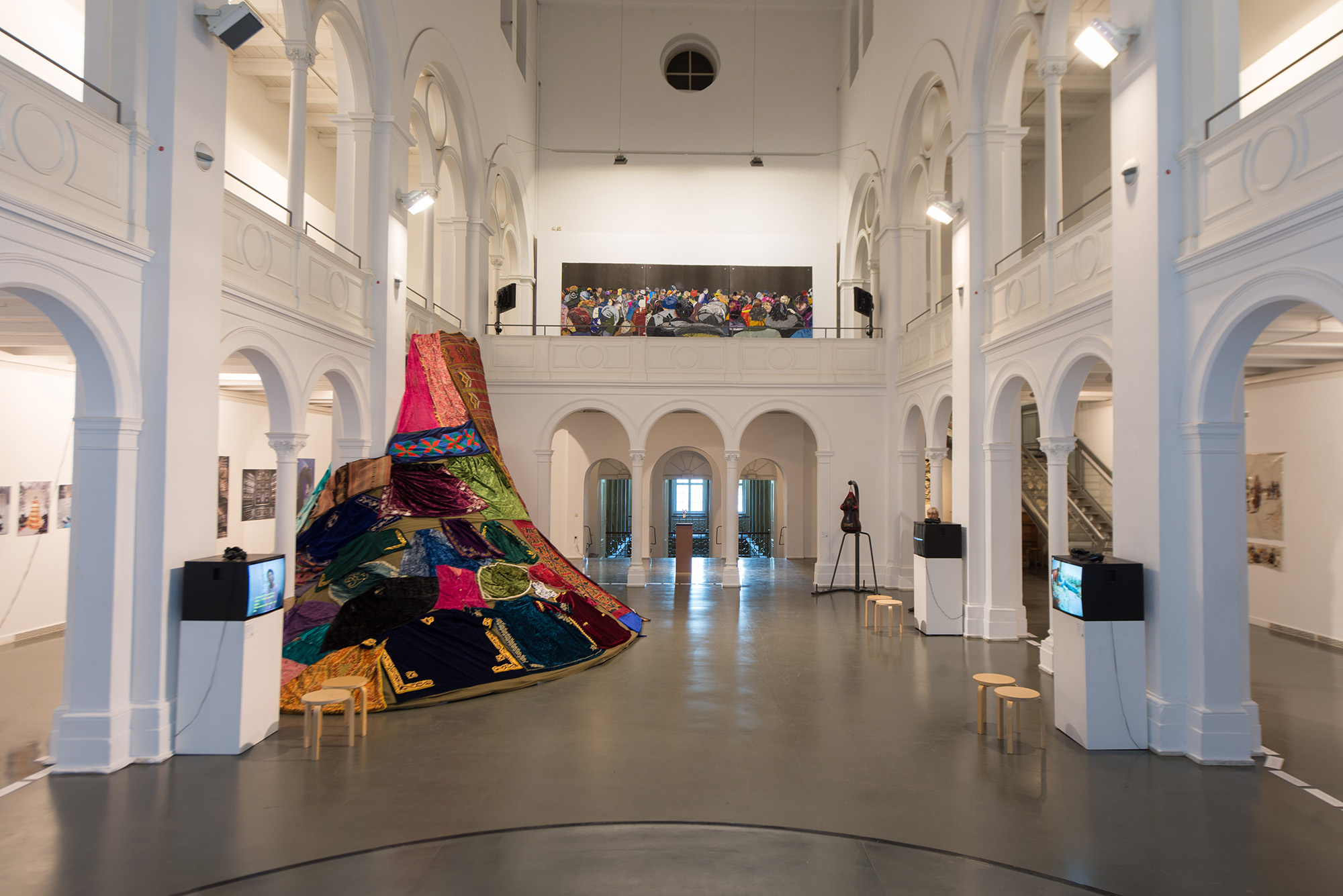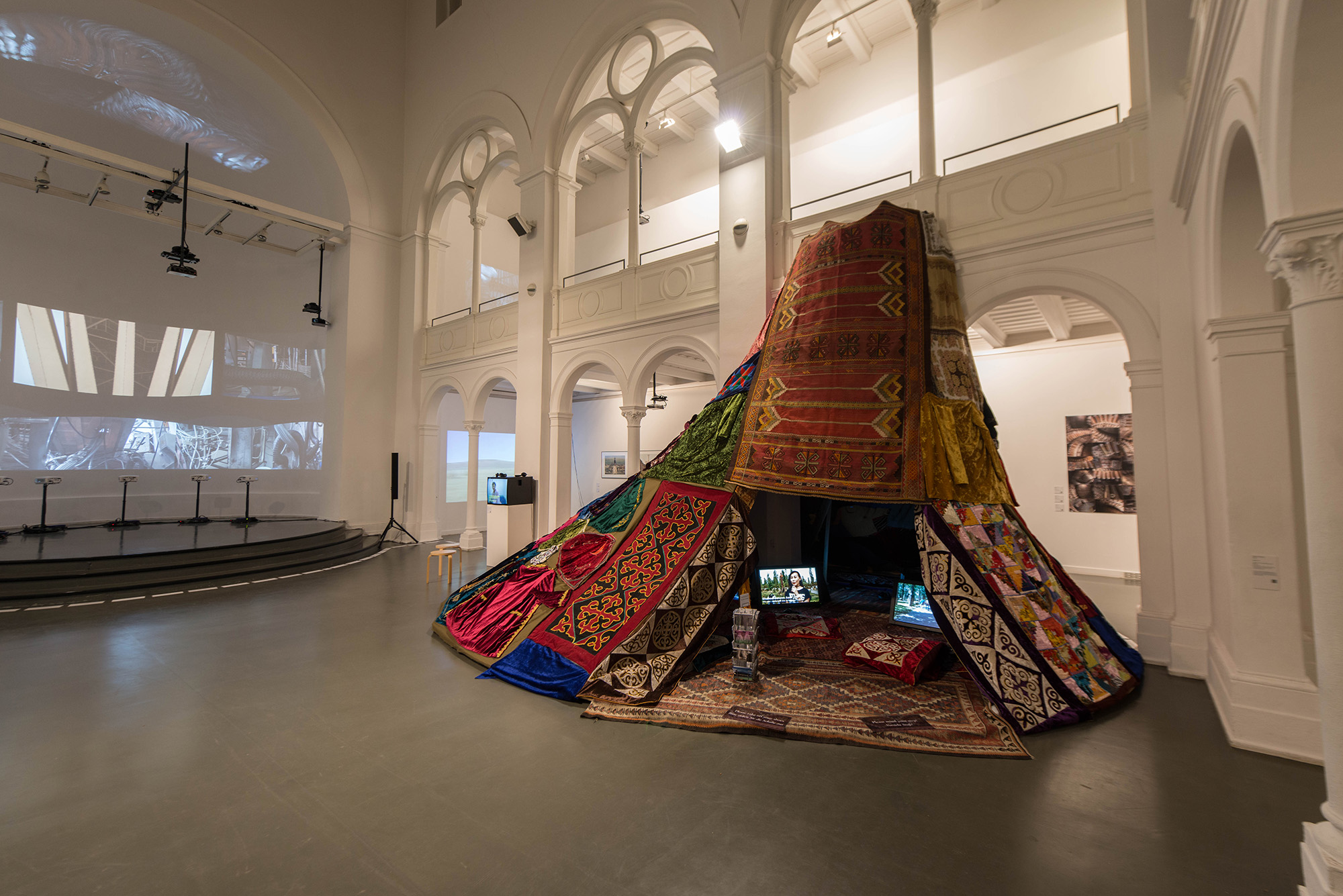Shows
“Focus Kazakhstan: Bread and Roses”


One windy day in September, the artist Almagul Menlibayeva invited passersby to participate in the Kazakh craft of koshmovalyanie (felt-making), a traditionally female communal activity. The workshop was organized by Momentum Berlin as part of the exhibition “Focus Kazakhstan: Bread and Roses,” an iteration of a four-part exhibition series developed with the support of the Kazakh government as a means of showcasing its culture to an international audience. With works by 20 female Kazakh artists created over the past century, “Bread and Roses” aimed to critically engage with the often omissive, patriarchal history of the country.
Self-evident, eye-catching works abounded. Adjacent to Gulnur Mukazhanova’s Iron Woman (2010)—a piece of lingerie viciously reinvented in golden metal fabric and pierced by long screws—Zoya Falkova transforms a punching bag into a female torso, the famous brand logo “Everlast” changed into the work’s title Evermust (2017). Both present a similar message: the female body as an ideological battleground.
The central hall was dominated by Gulmaral Tatibayeva’s one-story-high Untitled (2018) installation, featuring colorfully patterned women’s garments on scaffolding, which mirrors both the shape of a traditional nomad yurt, and that of the Norman Foster-designed Khan Shatyr Entertainment Center in Kazakhstan’s capital, Astana. At the interstice of an intimate family space—here, literally held together by women’s clothing—and a modern construction built for leisure and entertainment, Tatibayeva investigates how traditional values still have significance in contemporary Kazakh society, despite its embrace of a globalized consumer culture.

More subtle works, such as Bakhyt Bubikanova’s five-part photomontage series New Year’s Post Cards (2014), were displayed in the back of the space. With a paradoxical, theatrical undertone, Bubikanova arranges cut-outs of an absurdly high stack of bowls filled with meat, and reclining naked women in front of kitschy balloon curtains—a critique of the ultra-consumerist excesses of the nouveau riche. With her analogous presentation of naked flesh and raw meat, the artist plays on the simultaneously sexualized and domesticated image that media still project on Kazakh women. In her comical video Sebastian (2013), on the opposite side of the space, Bubikanova further interrogates the flattening of female identities in art and daily life. After parodying typical art historical depictions of the eponymous saint by leaning half-naked against a telegraph pole in the countryside, Bubikanova nonchalantly transitions into a washwoman resuming her routine task of hanging up laundry.
Saule Suleimenova’s elaborate “waste collages” made from plastic bags on polyethylene, which stood out next to myriad small-screen video works, tackled more specific issues affecting Kazakh people today. Skyline (2017) refers to an amendment adopted into Kazakh law in 2017 that required citizens to register temporary places of residency. The reform prompted mass queues in front of registration centers, causing two deaths, and conveniently led to the mass relocation of unregistered homeless people prior to the World Fair in Astana. On Suleimenova’s awe-inspiring, six-meter-wide plastic canvas, schematic backs of people stretch over the length of the work, referencing the waiting crowds. The gray clothing and fatigued, dark beige faces that dominate the canvas add to the despondent ambience.

Female artists of the early 20th century were highlighted throughout the second level of the exhibition, which included commercial art, as some figures evaded political persecution by taking jobs in the nationalized cultural and publishing industries. Among them, eminent avant-garde painter, illustrator and designer Vera Ermolaeva (1893–1937), who was incarcerated in a gulag for her “anti-Soviet” art and later executed, is exhibited with a print she produced for Russian author Ivan Krylov’s The Liar (1931), depicting elements from the humorous poem, namely the two protagonists with a supersized dark-green vegetable looming above them, albeit in somber, muted tones. Other exhibited Soviet artists luckily met a different fate. Gulfairus Ismailova (1929–2013) for instance, an actress, theater set designer and painter, focused her practice on national traditions and the role of working women in Kazakhstan. Her intricate designs for ballet and opera costumes in gouache on paper are displayed next to a 22-minute long documentary video on her oeuvre, produced by Menlibayeva.
Among the innumerable works on display, a desire to establish new perspectives on tradition and cultural roots loomed large. The show was a beginning to an expanded history of modern and contemporary Kazakh art, effectively navigating not only questions of changing national identity, but also subjects of gender connectedness, inter-generational dialogue and dominant discourses in art today.
“Focus Kazakhstan: Bread and Roses” is on view at Momentum, Berlin, until October 20, 2018.







